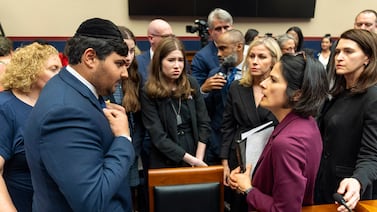Sign up for Chalkbeat Indiana’s free daily newsletter to keep up with Indianapolis Public Schools, Marion County’s township districts, and statewide education news.
This article was originally published by Indiana Capital Chronicle.
Where do Indiana’s six Republican gubernatorial candidates stand on school choice, teacher pay, learning loss recovery, and the state’s push to better prepare graduates for the workforce?
With a competitive primary just weeks away, the Indiana Capital Chronicle asked the six GOP hopefuls to weigh in. It’s part of four issue-based question-and-answers to be published ahead of the May election.
The following four questions on various Indiana education issues were distributed to: U.S. Sen. Mike Braun, Brad Chambers, Lt. Gov. Suzanne Crouch, Eric Doden, former Attorney General Curtis Hill, and Jamie Reitenour.
Each candidate was asked to limit their responses to 150 words, and answers were printed as submitted with only minor edits, like spacing or full names, for clarity.
Former Superintendent for Public Instruction Jennifer McCormick is the only Democrat on the primary ballot for governor. Additionally, one Libertarian, Donald Rainwater, was selected in a private convention process.
Lawmakers are considering moving to education savings accounts for all Indiana students. Do you support this move and if so, where do we come up with the new dollars to cover this major school choice expansion?
- Braun: School choice is about Hoosier parents having the freedom to make decisions about their kids’ education. Education savings accounts — where a student’s public funds are kept in an account similar to a Health Savings Account with parents in the driver’s seat — will be something I will look at closely. ESA programs have had success in states like Florida that have tried them, and I’m always looking for ways to put more power in parents’ hands when it comes to their children’s education.
- Chambers: Education is one of our greatest challenges but also one of our greatest opportunities. To take full advantage of this opportunity, we must give parents the ability to send their children to the type of school that best fits their individual needs. The state legislature has rightly made that ability nearly universal and eliminated unnecessary eligibility “pathways.” Additionally, buildings are getting bigger and administrative salaries are increasing, yet teacher salaries and classroom funding have remained relatively flat. That’s why we must first ensure current funding truly follows the student. From there, we’ll use the proceeds of a growing economy, paired with savings created by increased government efficiency, to further invest in education. We must make these investments to ensure that our third graders can read before moving on to fourth grade, and that our sixth graders are proficient in critical math skills.
- Crouch: Hoosier parents should have the maximum amount of choice and control possible when it comes to their children’s education. It is past time for us to have an honest and critical discussion about how we are going to educate our children in the 21st century, and to do that we need to reform education. By reforming I will take the five agencies that deal with education and workforce development and reduce them to one. We will concentrate the state’s efforts to prepare children for enlistment, enrollment, employment, or apprenticeship. By modernizing education, we will implement efficiencies and cost savings that will help offset any additional costs associated with educational choice. The investment will be worth it.
- Doden: Parents and students must have the freedom of school choice. That means charter schools, opportunity scholarships, education savings accounts, and vouchers — anything that breaks the government monopoly on schools and allows parents to make the best education decision for their child. Indiana has been a leader in school choice, and as governor, I will protect and promote educational freedom for Indiana families, especially for disadvantaged students trapped in failing schools.
- Hill: My education plan includes a major overhaul of the Indiana Department of Education. There is an unnecessary bloat of state administrators, and I plan to cut this in half freeing up money to be redirected to Hoosier students. This reduction in overhead will allow more dollars to flow to students and parents to make the best school choice for their situation. If strong options are limited, many students have no meaningful choice. That is why I will buck the status quo and ensure that schools and students have the resources they need to be successful.
- Reitenour: K-12 education is first and foremost for our kids to be focused on achieving their dreams. Test scores reveal we are getting an “F” in education. We cannot throw money or programs at problems expecting things to change – we need to address what is happening in the classroom. I will introduce a back-to-basics overhaul of our public education learning objectives. We will remove technology and devices from K-5 classrooms while kids focus on educational foundations: reading writing, and arithmetic. Private sector partners will adopt-a-classroom of 6th graders to introduce technology, AI, and workforce opportunities of the future, and will teach trades classes to 7th and 8th graders. School Improvement Programs will no longer be littered with DEI, SEL, and social justice goals, but solely on academics. I support vouchers and school choice, which provide once-unheard-of opportunities for families of all socio-economic statuses, while putting positive competitive pressure on public schools.
Note: State lawmakers approved a massive literacy overhaul measure during the 2024 session that will require reading-deficient third graders to be held back a year in school. In 2023, the General Assembly included in the state budget a voucher buildout that makes Indiana’s current Choice Scholarship program virtually universal.
Currently, ESAs in Indiana are limited to students who require special education services, though a law passed earlier this month expands eligibility to the siblings of students who have an ESA, even if those siblings do not have disabilities themselves.

Indiana’s average teacher salary is currently about $58,531. Gov. Eric Holcomb’s goal has been to increase that average to $60,000. What, if anything, should the state do to raise teacher pay and increase recruitment and retention of Hoosier educators?
- Braun: We spend over half of our budget on K-12 education. Are we getting the best results we can from that investment? We need to make sure Hoosiers’ investment in education is being spent wisely on things that will give students’ better outcomes — like attracting and retaining great teachers — and not being gobbled up by administration, waste, or programs that aren’t showing results. I’ll approach our K-12 education the same way I approached solving problems in my business: rolling up my sleeves and making sure every dollar is getting maximum return for Hoosiers.
- Chambers: Teaching is a noble profession — one that is essential to our social and economic futures. But for decades, it hasn’t been treated as such. Teachers must be paid more than they earn today, and their pay should be based on their performance in the classroom and the outcome of their efforts, not simply on the length of their tenure. Teachers who work hard and improve education outcomes must be able to earn a higher salary faster and earlier in their careers. Additionally, teachers in high-demand subjects, such as STEM subjects, should be able to earn higher salaries so schools can compete with other employment opportunities for the best talent.
- Crouch: I support the goal to increase the average teacher salary to $60,000 (which will bring Indiana closer to the national average). Beyond the mere financial benefits of increased pay, a greater investment will value our teachers and their crucial role in preparing our children for the future. Beyond pay, however, our teachers must have a seat at the table as we create a lifetime education model for Hoosiers. As governor, I will ask teachers and parents for their advice, counsel, and ideas as it relates to preparing our children for college, the military, their careers, or workforce training. As a result of my education reforms, we will be able to direct more money to the classroom and less to administration.
- Doden: I am the only candidate for Governor with a plan to address Indiana’s teacher shortage. Education is enshrined in Indiana’s Constitution as a priority for very good reasons. Any state that strives for excellence must invest in educating its population. Unfortunately, many of our best teachers are moving on. Currently, there are thousands of teaching vacancies across Indiana and fewer than 15% of our teachers are under the age of 30. Our Teacher Investment Program would attract and retain teaching talent by eliminating the state income tax for Hoosier educators. This approach will put money back in the pockets of teachers, where it is intended, rather than in the hands of bureaucrats or teachers unions.
- Hill: As the husband of a public school teacher, I understand many of the challenges facing Hoosier teachers. I believe we can implement my statewide policy at the local level, reviewing unnecessary overhead and eliminating useless bureaucratic costs. If each school district reduced its costs this way, it could allocate those funds to attracting the best trained teachers through competitive salaries. Our educators play a crucial role in the success of our students, and we owe it to them to ensure they have what they need to keep our kids in school.
- Reitenour: I want the teachers in Indiana to know that I see them, I appreciate all that they do, and hard work pays off for our kids as well as the teacher. Excellent educators must be compensated for retention and starting pay must be competitive to attract young talent. Across-the-board pay increases do not improve our children’s educational outcomes. We will set incentive pay standards for teachers and districts meeting their School Improvement Plan goals. These opportunities are normalized on the unique starting points and challenges of each school. The Indiana Goodness Education plan includes the CCC (College? Career? Or Calling?) high school initiative, and senior year apprenticeships. These will drive our ability to close workforce shortage gaps, like pilots and trades, with the students who have worked toward those professions. Providing vision to the next generation shapes Indiana’s future workforce, and saves secondary education spending that can be reallocated to incentive pay.
Note: Currently, Indiana law requires a minimum salary of $40,000 for each full-time teacher. Most, but not all, Hoosier districts currently meet the salary requirement, however. State data released earlier this year showed that — while the Indiana teacher workforce is growing — fewer teachers are being retained.
In recent years, multiple initiatives spearheaded by Indiana lawmakers and state education officials intend to boost teacher numbers. That includes scholarships and multiple other incentive programs meant to recruit and retain students in education preparation programs.
The COVID-19 pandemic contributed to significant levels of learning loss for students across Indiana. Recovery efforts are still underway. What more do you want the state to do to get Hoosier kids back on track? What role(s) should parents play in the comeback?
- Braun: It wasn’t the virus that caused learning loss for our kids, it was keeping schools shut down and our kids in masks long after it was clear that it didn’t make sense. My approach to education comes as a parent and from serving on my local school board for 10 years. Parents are the primary stakeholder in their kids’ education. I clashed with the Biden administration’s Secretary of Education at a Senate hearing when he wouldn’t accept that simple fact, and it will be the centerpiece of my approach to education as governor.
- Chambers: We simply can’t close our schools again, which only exacerbated unacceptable educational trends of Hoosier students underachieving in math and reading. We must ensure that third graders can read before moving on to fourth grade, as those who can’t are four times more likely to drop out of school altogether, and I applaud the state legislature for their work on that this past legislative session. We also need to utilize new technology to individualize education to meet each student’s needs, increase the focus on skill-based education and combat chronic absenteeism. Parental engagement is vital in getting all of this done.
- Crouch: As a result of COVID, depression is up 60% among our young people — and, sadly, suicide is now the second leading cause of death for our youth. As governor, I will not allow a repeat of the school closings, mask mandates, or lockdowns that marked the height of the pandemic. COVID re-awakened parents regarding their children’s education and involved parents will guarantee successful outcomes. I join parents in calling on schools to teach kids how to think — not what to think. We will concentrate on the Four Rs: reading, ‘riting, ‘rithmatic, and reasoning with an emphasis on civic education to develop strong citizens.
- Doden: This isn’t just a question about COVID learning loss recovery. It’s about tackling the challenges and opportunities Indiana’s education system faces. Our education system simply isn’t doing enough for our kids. As a conservative, I believe there are common-sense solutions that can turn this around and give every child access to a quality education. We all want what’s best for Hoosier students. In a Doden administration, we promise to keep politics out of the classroom, ensure parents must have the freedom of school choice, recruit and retain the best teachers, and expand access to pre-K and put a renewed focus on the transition from high school to college or work.
- Hill: We must get back to the basics. Instead of social and emotional learning through a political lens, we need to focus on core competencies like reading, writing, arithmetic, and civics. Let’s remove the politically charged curriculum at the elementary and middle school levels so that more third graders can read. Parents should play an integral role in ensuring their children receive the best education possible. Any efforts to distance parents from their children are doing a disservice to the quality of their child’s education. The pandemic gave parents a front-row seat to the crazy curriculum that many educators were using, and they should continue to identify and protest these unnecessary and dangerous lessons.
- Reitenour: Back-to-basics education, teacher incentives, parent engagement, learning-loss assessments, targeted remedies, and School Improvement Plans are all going to play an important role in impacting the COVID learning loss, which leaders never should have allowed to happen in the first place. Parents are the “Forever Teacher” and there is no greater supporter, encourager, or advocate for any child. We will make it easier for parents to be involved in their children’s education, and forbid teachers from introducing non-educational concepts that are kept secret from parents. We want students to know Indiana Goodness believes in “making a way” for every child to achieve his or her God-given ability. Gifted & talented programs are essential for our top learners to be pushed and reach their full potential. Evaluations will become standardized, not Indiana-specific, so that they are useful for driving improvements and eliminate ambiguity with where we stack up.
Indiana is in the midst of increasing credentialing and educational attainment among Hoosiers. Much of the prior emphasis has been on college-going and degree attainment, but new initiatives are increasingly focused on career- and skills-based learning. What do you think is most important for Indiana to focus on now as the demand for skilled workers grows?
- Braun: We have not done enough to encourage career and technical education. Every student in Indiana needs to know that a four-year degree is not the only path to a good-paying, fulfilling career. As someone who has employed thousands of Hoosiers, I know that there are many skills that Indiana businesses need right now that are not being addressed at scale. Touring all 92 counties every year, I’ve seen excellent examples of high school programs that partner with Hoosier employers to empower students to work on real world skills like CNC manufacturing where they can hit the ground running on a good-paying career right out of high school. We need to foster and expand these programs.
- Chambers: The high-wage careers of an economy of the future will not only be for Hoosiers with a four-year degree, but Hoosiers with a two-year degree, credential or certificate, too. That’s why Indiana must continue to promote the traditional college-going path. But we must also equally promote the two-year college path, as well as skills-based continuing education. To help Hoosier students understand which path they should take, we must better communicate clear career pathways to them, including the type of postsecondary education they need to pursue. For some careers, that’ll be a four-year degree. However, for many others, that’ll be a two-year degree, a credential or a certificate. And to help those students pursing the latter, we should expand the scope of Indiana’s financial aid programs to support them. Regardless of which pathway a student decides is best for them, it’s important that we support it so they can maximize their earning potential right here in Indiana.
- Crouch: I will create a lifetime education strategy and reduce the state bureaucracy by taking five agencies — early childhood education at FSSA, K-12 education, higher education, workforce development at DWD, and part of IEDC— and merging them into one system dedicated to providing the talent and workforce to meet Indiana’s economic development goals. This will include measures such as discontinuing or restructuring the Department of Workforce Development (DWD), removing career education responsibilities from the Commission for Higher Education (CHE), and reforming the Indiana Economic Development Corporation (IEDC) to realign with its original framework. We will merge state agencies — not local school districts. The plan is tailored to Indiana’s specific economic context, addressing current gaps in workforce skills and education. This alignment ensures we will be preparing students to fill the jobs of today and tomorrow — not only jobs in advanced manufacturing, defense technology, and biosciences, but also careers in infrastructure and skilled laborers that will help build our state.
- Doden: Conservatives should make the beginning and end of public school the next focus of education reform by providing innovative and local approaches to early education and the transition out of high school. Studies show that the state of Indiana saves $4 in future costs for every dollar invested in education opportunities for children ages three to five. As governor, we will provide state matching funds for any community that wants to create high quality pre-K programs for four-year-olds. By incentivizing local collaboration, innovation, and investment, we will foster community-based solutions that will neither break our state’s budget nor dictate one-size-fits-all approaches to local communities.
- Hill: We need to continue to invest in trade and vocational programs for high schoolers and young adults. I have met with school and labor leaders across the state to understand how to support trade workers so that young Hoosiers will continue to see prosperity in these fields. We need to create a culture of celebration for trade and vocational programs similar to that we give college students. Investing in education and supporting the industry will strengthen our support of all career paths for young Hoosiers. College is not for every Hoosier, and we should be giving every child the tools and resources the need to live a successful life.
- Reitenour: I am ALL IN for our kids’ unique giftedness to be harnessed into a vision for their futures, whether it is skilled work, advanced education, military service, or other creative endeavors. A one-size-fits-all approach is not the educational solution to students achieving their own personal bests. Our students need to learn from the cherished Hoosiers who have been in their shoes. U.S. Veterans will have opportunities to speak about freedom, patriotism, and military service to our students. Private sector leaders, entrepreneurs, and business owners have much to offer our students, and much to gain from our state’s future workforce. They will engage from 6th grade technology and innovation “adopt-a-classroom” to approved senior year apprenticeship programs. With this vision for Indiana’s public education, we will become the training capital of the United States! Now is the time for every child to reach his or her potential – that is Indiana Goodness!
Note: Indiana is in the midst of a new technical education overhaul for highschoolers across the state that seeks to increase work-based learning opportunities and transform how younger Hoosiers get job-ready.
The latest state data showed that only half of Indiana’s 2021 high school graduates pursued some form of college education beyond high school. It marks the state’s lowest college-going rate in recent history, but the decline has been ongoing for the last five years.
The Indiana Capital Chronicle will be sharing two more stories in this same format on taxes and the environment — for which questions have already been shared with the candidates — and publishing next week. The GOP hopefuls have already shared their thoughts and positions on the economy.
Indiana Capital Chronicle is part of States Newsroom, a network of news bureaus supported by grants and a coalition of donors as a 501c(3) public charity. Indiana Capital Chronicle maintains editorial independence. Contact Editor Niki Kelly for questions: info@indianacapitalchronicle.com. Follow Indiana Capital Chronicle on Facebook and Twitter.






